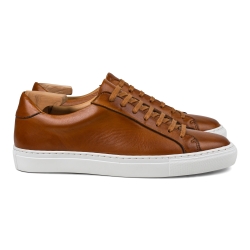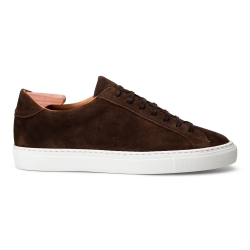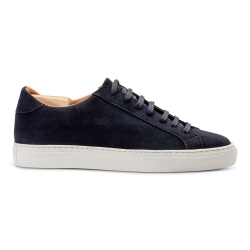Sneakers
We have serious contenders to the best bang-for-the-buck sneakers and trainers in the world. For our premium sneakers and trainers manufactured in Portugal we've taken all our shoe knowledge and gone into every detail of the shoes, to get specifications that are absolutely top-notch. For example chrome free leathers, heel stiffeners in leather board which conforms to your feet (standard is plastic), midsole in real leather (instead of cardboard or textile felt which is standard), and so on.
Many brands aren't even aware of all the parts of their shoes, how they're made and what materials have been chosen, but all of these parts have a big impact on both the comfort and durability of the shoes. When one know what can be achieved down to the smallest detail, and work with the right manufacturers, you can go extremely far yet still keep the price at a very competitive level.
We've also got a slightly simpler range with really nice sneakers, and a selection of ultralight and comfortable sneakers from Swims which are machine washable.
Which sneakers are of the best quality?
In the world of sneakers, there are, unfortunately, a lot of shortcuts when it comes to the level of quality, here the design and marketing is more important than the level of the material and construction itself. This is not only true for the big brands, but also brands that focus on more expensive quality sneakers often take shortcuts, not least when it comes to the choice of materials for parts that are not as obvious to the customer, but which are noticeable over time.
A clear example is the so-called lasting board, which is found under the removable insole on sneakers and sports shoes. It's more often than not made of paper fibre board, even on shoes costing more than €300, a material that doesn't handle moisture well and therefore often wears down quite quickly and is the part of the shoe that breaks first. Another common material is a form of fabric felt, which, like fibre board, absorbs moisture, and instead of wicking it away, encapsulates the moisture in the shoe. In our premium sneakers and trainers, we use a midsole made of real leather, which is long-lasting, moisture-resistant and also breathable, carrying moisture away from the foot into air pockets on the inside of the outsole itself.
Another example is the heel stiffener, the inner part of the heel that provides support, which on sneakers is almost always made of various types of plastic material. Here, on our premium sneakers and trainers, we have chosen to use the same material as in our welted shoes, which is leather board (leather dust mixed with glue and pressed into malleable plates), which moulds itself to the foot in a much better way. Padding often makes this less sensitive than on dress shoes, but people with sensitive feet in particular experience a higher level of comfort with leather board heel stiffeners also on sneakers.
In addition to the aforementioned elements, our premium sneakers are made with specifications that are hard to beat, like chrome free uppers on our smooth leather shoes, the thin lining leather on the inside of the shoes is vegetable tanned for best breathability, the thick built-up insoles are lined with vegetable tanned leather, in the case of our sneakers they are made with sidewall stitched construction that allows for resole, and so on. All parts are thought through for really high quality.
Can sneakers be resoled?
Most sneakers cannot be resoled, then it's a matter of adding new wear parts on the outside of the sole, but if they are made with so-called sidewall stitched construction, as is the case with our premium sneakers, it's possible. This requires the cobbler to have a sidewall stitch sewing machine, which has become more and more common in many parts of the world in recent years.
How do I best care for my sneakers?
Leather sneakers, like all shoes, benefit from being treated with shoe cream or some form of conditioner, to moisturise and protect the leather, and keep it looking good for a long time to come. If they get dirty, it's a good idea to wash them from time to time, for example with the superb shoe pocleanerlish Tarrago Factory Sneakers WASC! Super cleaner. Then treat them with a shoe cream or a conditioning cream such as Tarrago Factory Sneakers Rescue Conditioner afterwards.
Sneakers made of suede, nubuck or textile should be periodically sprayed with a good waterproofing spray, such as Tarrago Factory Sneakers Nano Protector, and otherwise cleaned in the same way as leather sneakers.
If you have white or black soles, you can use Tarrago Factory Sneakers Total White or Total Black, which is a sole paint that restores the crisp, rich colour of the soles.
All shoes benefit from resting between uses to allow them to dry properly. It's therefore recommended to always have at least two pairs of shoes per season to alternate between, and preferably insert cedar shoe trees when shoes are resting to help them retain their shape in the best possible way.
What is the story behind GAT sneakers?
The story behind the famous GAT sneaker model is really interesting. In the 70s, the West German army needed new training shoes for their soldiers, a big contract that the two German firms Adidas and Puma were fighting over. Two fierce competitors founded by two brothers, Adidas by Adi Dassler and Puma by Rudolf Dassler.
Curiously, it's said that it was Puma who designed the first GAT sneaker, but for some unknown reason they never produced it, instead it was Adidas who made the original editions for the West German army.
The iconic design and variations of it have since been made by several different manufacturers over the years, most notably popularised by the French Maison Margiella. Our own version, available in several colours, is made in Portugal to the same high standards and with the same great comfort as our other premium sneakers, and has become a real hit.
There are 55 products.























































